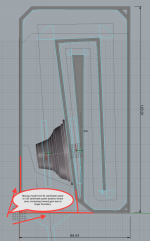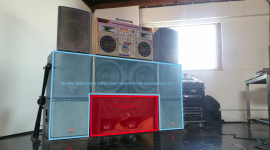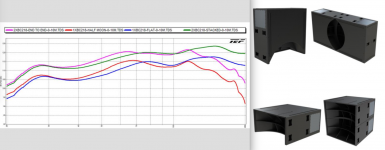Jennygirl,Does anyone have experience with cowls on TH's? I am so very curious if this will affect near field vertical dispersion one bit. I suppose at such low frequencies I'll probably be hearing the room more than anything else, but perhaps there is an effect? Can something look so good that it ends up sounding better?
What do you mean by "cowl" in terms of a TH?
An angled mouth exit won't have any effect on "vertical dispersion" at the low frequencies (<60Hz)you plan to operate this sub .
That said, increasing frontal area does increase forward gain, your design would have a few dB more output in front if the mouth exit was on the long dimension, cabinet "standing up", rather than "laying down".
Art
Eliminate the corner reflectors. In jbell's ss15 thread, he talks about how they take away the modeled volume and reduce spl.
Noted, that info sounds familiar! Guess that just makes the build even easier too
Jennygirl,
What do you mean by "cowl" in terms of a TH?
An angled mouth exit won't have any effect on "vertical dispersion" at the low frequencies (<60Hz)you plan to operate this sub .
That said, increasing frontal area does increase forward gain, your design would have a few dB more output in front if the mouth exit was on the long dimension, cabinet "standing up", rather than "laying down".
Art
Hi Art! Good to see that you're still here and thanks for the response! What you say is kind of what I was already figuring, but my dumb hunch remains about a smoother air coupling.
By cowl I meant the waffle style panels / supports in the end of the mouth.
Part of the reason I am splitting this sub into two cabinets (besides portability) is so I can experiment with configuration. Thanks for the info about the longer dimension of the mouth having a slightly wider dispersion. I will test both axes.
~ ~ ~ ~ ~ ~ ~ Build Plan ~ ~ ~ ~ ~ ~ ~
Hopefully I'll be able to find some time to start building these asap, too excited to not!
The build process is going to be quite different this time around as I'll be cnc laser cutting a few key parts (to use like a jig). Namely, I'll be cutting out the horn shape itself (to use as an internal jig) out of some 1/8" hardboard/eucaboard I have laying around, gluing it to the inside of the sidewalls and slotting my baffle/fold pieces without having to measure anything. Braces will be cut out of 1/4" or 1/2" ply on the laser as well. The sidewalls and baffles will be 3/4 ACX glued with PL and nailed with 1.5" brads.
Jennygirl,Thanks for the info about the longer dimension of the mouth having a slightly wider dispersion. I will test both axes.
Perhaps the changes to your plan below will more clearly illustrate what I had in mind when I wrote "increasing frontal area does increase forward gain, your design would have a few dB more output in front if the mouth exit was on the long dimension, cabinet "standing up", rather than "laying down".
The mouth would be on the left side rather than the bottom, effectively doubling the frontal dimensions, adding forward gain due to the larger boundary.
Art
Attachments
Last edited:
Jennygirl,
Other speakers if plugged in to a live amplifier, or cases, or purpose built "barn doors" all increase the frontal boundary area, which increases forward gain.
"Baffle Step Correction" on steroids ;^).
These two threads may be of interest:
Horn Extender/Wave-guide for TH
Multiple Cabinet Combined Response
The frontal area of the stack makes a significant difference in response shape, adding “wings”, flat pieces of plywood (AKA “barn doors”) to the stacks add 2 to 3 dB to the LF response when the frontal area is tripled.
Art
Other speakers if plugged in to a live amplifier, or cases, or purpose built "barn doors" all increase the frontal boundary area, which increases forward gain.
"Baffle Step Correction" on steroids ;^).
These two threads may be of interest:
Horn Extender/Wave-guide for TH
Multiple Cabinet Combined Response
The frontal area of the stack makes a significant difference in response shape, adding “wings”, flat pieces of plywood (AKA “barn doors”) to the stacks add 2 to 3 dB to the LF response when the frontal area is tripled.
Art
Last edited:
Art- neat threads and research! I wonder at what point of 'porosity' that the frontal area is effectively 'broken up'.. I.e. if the effect is reduced when the frontal area is largely made up of horn mouths.
Either way, pretty cool. Makes me feel very good about having everything set up in a singular stack
Either way, pretty cool. Makes me feel very good about having everything set up in a singular stack
Jennygirl,I wonder at what point of 'porosity' that the frontal area is effectively 'broken up'.. I.e. if the effect is reduced when the frontal area is largely made up of horn mouths.
Good question, I have no specific measurements to give you an answer.
Based on my experiences with large "all horn" systems, my empirical subjective guess would be that as long as the adjacent horn mouths were either driven or drivers shorted, they would have a similar effect as "barn doors" of the same area.
Back to your sub's construction, you could try an exit configuration similar to the DSL "Boundary Coupled" BC-218, to allow use in either vertical or horizontal configuration. Note the "free gain" (as much as 4 dB) from 20-70Hz doubling the frontal area imparts in the "Half Moon" and "End to End" orientations.
Art
Attachments
Hello Jennygirl,
yes i know , this is an old thread.
....but last night i did some calculations around your design with different drivers. Just for fun...to have a stating point for a similar project.
SPL, phase etc. look good.
I've some problems with the impulse response.
How would you describe the sound of the tapped horn?
yes i know , this is an old thread.
....but last night i did some calculations around your design with different drivers. Just for fun...to have a stating point for a similar project.
SPL, phase etc. look good.
I've some problems with the impulse response.
How would you describe the sound of the tapped horn?
- Status
- This old topic is closed. If you want to reopen this topic, contact a moderator using the "Report Post" button.
- Home
- Loudspeakers
- Subwoofers
- FaitalPRO 15HP1060 vs 3015LF for tapped horn?


